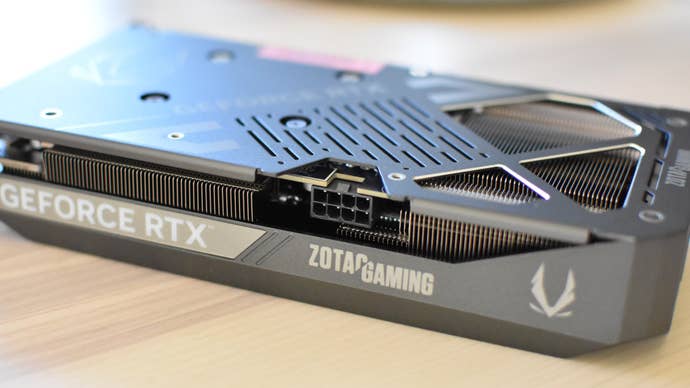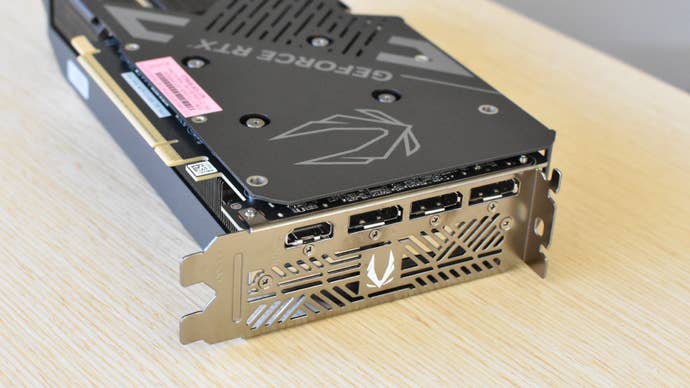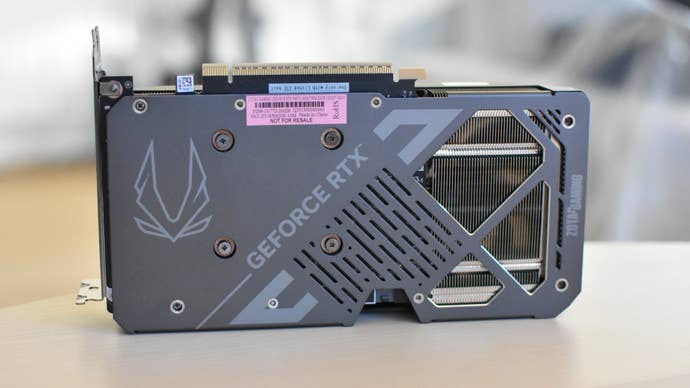If PC gaming was a house, the chairs, tables, and at least one pouffe would be make out of Nvidia XX60 graphics cards. No other GPU lineage accounts for as many builds or playing hours, though the fact that we love them so much does make it hurt worse when they go astray. As the 16GB version of the RTX 4060 Ti did, when it launched at a withering $499.
This time, the RTX 5060 Ti is still getting separate 8GB and 16GB flavours, but Nvidia have remembered that yes, this is still supposed to be a mid-range card. Thus: price cuts, with the 8GB model starting from £349 / $379 and the 16GB from a sharply dropped £399 / $429. The gen-on-gen speed upgrade is merely moderate, though between that cost cutting, the option of DLSS 4 and Multi Frame Generation (MFG), and performance-per-watt that beats the already efficient 4060 Ti, it still makes for a reasonably appealing new addition to the GeForce dynasty.
I’m reviewing the 16GB version here, or to be more exact, the Zotac Gaming GeForce RTX 5060 Ti 16GB Twin Edge. Which, for the record, is an excellent bit of third-party card building, being almost unnervingly quiet under load despite GPU temperatures only peaking at 61°c. Its use of a totally bog-standard 8-pin power connector also hints at the RTX 5060 Ti’s frugal power needs, with both 8GB and 16GB versions rated at 180W – easily enough to get by without one of Nvidia’s tendrilly, multi-plugged adapters.

In fact, I barely even approached that maximum in all my hours of playing and benchmarking the RTX 5060 Ti. It instead peaked at just 155W during a spirited Cyberpunk 2077 session, which is actually just below the peak wattage of 157W I measured on my 8GB RTX 4060 Ti. If efficiency and cooling form the base of your hierarchy of GPU needs, it’ll be worth waiting until May to see how the 145W-rated RTX 5060 fares as well, but good on the RTX 5060 Ti for outmanoeuvring its immediate predecessor on what is – or was – one of its biggest strengths.
Nvidia GeForce RTX 5060 Ti 16GB review: 1440p benchmarks
The RTX 5060 Ti continues the grand old XX60 Ti tradition of smooth yet relatively budget-friendly 1440p performance. And, next to the pricier RTX 5070, it makes more of an effort push native-rez, pre-DLSS framerates forward from the days of the 40 series.
Averaged across all seven games, the 16GB RTX 5060 Ti works out about 19% faster than the 8GB RTX 4060 Ti, an acceptable (if not terribly dramatic) improvement. That might also be an unfair comparison, were it not for the fact that the 16GB RTX 4060 Ti is, by all accounts, barely any quicker than the 8GB version. Hence the aforementioned hurt.
That does also raise the question of whether the 8GB RTX 5060 Ti is the better deal as well, and I wish I had the time to get one in on these graphs. I do suspect, though, that now that the 16GB version imposes much less of a financial burden, the extra VRAM could very feasibly make it worthwhile. The last two years have seen higher-fidelity games get ravenously hungry for memory, and at 1440p especially, having that bigger buffer could help more than it did in 2023.
In any case, you’re also looking at a substantial performance uptick from the RTX 3060 Ti – good news if you skipped the RTX 40 generation altogether – and again, that upgrade to performance-per-watt isn’t nothing. As a sub-£500 option for fast 1440p, then, the RTX 5060 Ti delivers, often without needing to resort to upscaling at all.
That said, DLSS 4 remains the best of its kind. AMD’s FSR 4 makes encouraging improvements, but to my eyes still doesn’t match DLSS sharpness. And, in terms of straight numbers, the RTX 5060 Ti’s MFG support lets it pull much further away from the 4060 Ti when frame generation is involved.
I don’t actually endorse path tracing on the RTX 5060 Ti at this resolution – it will handle regular ray tracing with just a dash of DLSS upscaling, but nobody should buy a cutting-edge GPU just to sit around the 30fps mark. Nonetheless. This GPU does achieve general playability where the RTX 40 mid-rangers don’t, and with 4x MFG it’s capable of more than doubling their best showings. That came with heaps of added input lag, mind, so if you do fancy some frame gen, I’d recommend reducing your quality settings at the same time. This will help secure the supply of ‘real’ frames, which in turn will help limit latency spikes.

Nvidia GeForce RTX 5060 Ti 16GB review: 1080p benchmarks
As you’d hope, the RTX 5060 Ti is comfortably equipped to handle max-quality, native-rez games at Full HD. Its average performance increase over the RTX 4060 Ti contracts slightly, to 18%, but it’s still a more meaningful and consistent upgrade than the RTX 5070 is over the RTX 4070 Super.
That said, the last-gen model is hardly getting its ribs kicked in either, and since both GPUs often hang out in the same 80fps+ area, it’s sometimes harder to spot the difference than it is at 1440p. That does change, however, when you start slapping on the really high-end visual options.
By staying above 40fps in both these games, the RTX 5060 Ti arguably becomes the first XX60 card that can really, truly cope with path tracing. With Alan Wake 2 in particular, there’s a noticeable difference in smoothness between the 4060 Ti’s 36fps and the 43fps of the new model, as these kinds of framerates are (unlike the rasterised results above) well below the point where diminishing returns spoil the fun. Despite an oddly limited 4x MFG result in the same game, that stronger framerate base also makes the 5060 Ti better suited to frame generation.
I’d still want to see how the Ti-less RTX 5060 performs at 1080p before parting with any cash – the 8GB VRAM limit is starting to look a tad old-fashioned, but it’s still fine for 1080p rigs that aren’t minded to switch to 1440p anytime soon. And I’d still take the RTX 5060 Ti over its more immediately available rivals: besides the RTX 4060 Ti lagging behind on both straight performance and performance-per-watt, the Intel Arc B580 comes in a lot cheaper but a lot slower as well. The AMD Radeon RX 7700 XT gives an encouraging first glance – I only have benchmark results from the old RPS test rig, hence why it’s not in these graphs, but at 1080p it did average 121fps in Cyberpunk 2077 and 107fps in Metro Exodus, so on a newer CPU it should run very slightly faster for about the same cash as this 16GB RTX 5060 Ti. However, it lacks the FSR 4 support that’s currently exclusive to the very latest RX 9000 GPUs, leaving it without a convincing consolation prize for simultaneously forgoing DLSS 4.

We can therefore chalk the RTX 5060 Ti as one of the more successful RTX 50 graphics cards, and the current de facto choice for – at the very least – 1440p on a budget. This specific Zotac model also makes a convincing case for itself, impressing on thermals and quietness even while sticking to the 16GB GPU’s base price of £399.
In the UK, anyway. The toupéed elephant in the room, of course, is the looming impact of US tariffs on computing hardware. There’s no smartphone-style exemption for graphics cards, so it would be troubling yet unsurprising if the RTX 5060 Ti suddenly gets pricier in the States. That would, in truth, make it a harder sell – though I suppose since all the other alternatives would suffer the same fate, there would be a kind of equality to the misery.
This review is based on a retail unit provided by the manufacturer.










Add comment